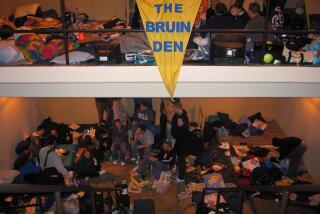Lost L.A.: A Cold War bachelor pad that really knew how to swing
The current crop of television bachelors is pitiful. They settle for sex-lite in the pool, Champagne magnums, satin-lapelled tuxedos and RV limos. Worse, they’re short the ultimate endowment: the bachelor pad, depriving male viewers of inventive solutions to single living. West Hollywood millionaire bachelor Hal B. Hayes would have laughed at these Romeos.
Bachelor life is a dicey choice, subject to changing norms. In the 19th century, marriage was an expensive commitment. Husbands were expected to support their wives, who stayed at home. Thousands of unmarried men, many recent immigrants, lived in cities, cared for by restaurants, laundries and boardinghouses. By the 1920s and 1930s, a “bachelor” was an older, eligible man. His decision not to marry was suspicious. Was he deviant or, worse, homosexual?
Then came postwar USA and the baby boom. Though the standard became a wife and kids in the ‘burbs, bachelorhood was acceptable again, envied for its free-spending style and dating privilege. In 1953, Hugh Hefner launched Playboy magazine for the liberated, single man, and L.A. contractor Hayes designed and built an Atomic Age playpen above Doheny Road.
For $600,000 -- adjusted for inflation, about $4.9 million today -- Hayes got a six-level, steel-and-glass pad with masculine, maximum technology and minimal custom decoration. He parked on girders projecting from the edge of his hillside lot, piped in hi-fi music, poured drinks from an ultra-sleek mini kitchen designed for catering, not for cooking, seduced brunettes in an orchid greenhouse and did what bachelors do in a free-standing “playroom.”
There was a circular fireplace, a louvered skylight, a mirrored master suite and an artificial beach for topless tanning. An outdoor hearth in gunite lava rock warmed women chilled by gin martinis.
The cultural paranoia of Hayes’ generation was imminent nuclear war. Images of Hiroshima and Nagasaki were on the minds of newlyweds across America when they built basement shelters against communist attack. Hayes constructed a steel-shuttered safety room and exterior walls with deep, rounded ridges for shock resistance. He installed an automated carpet that could rise from the floor and shield a three-story window in the event of a glass-shattering explosion. A rooftop garden insulated rooms from extreme heat, and fire-retardant paint preserved redwood trim.
The ne plus ultra of nuke chic was an indoor-outdoor pool, winding from a tropical lanai through entertainment rooms. At one end was an underwater tunnel leading to a sealed, underground cave aerated with oxygen tanks. Hayes calculated that a frantic swim to reach the shelter would detox the body after an A-bomb explosion.
Bachelorhood is an art, and Hayes was a master. He lured the famous and rich to his hive. At a housewarming party in May 1953, the groomed, silver-haired builder and swimsuited socialite/starlet Kay Spreckels watched actress Roxanne Arlen take a radiation-free dip in the pool, churned by a 40-foot waterfall. As a waiter in uniform served cocktails and hors d’oeuvres, fears of a Soviet invasion faded in a boozy haze.
Neither broads nor bombs took out swinger Hayes. Corruption did. He borrowed low-interest millions under the federal Capehart Act of 1955, passed to encourage home construction. Loans came due and Hayes was delinquent. The government questioned how Hayes had paid for a platinum and diamond ring he bought for Hungarian temptress Zsa Zsa Gabor in a failed attempt at marriage.
Hayes ponied up $8 million to settle a federal fine, gave up his pad and headed to Mexico in ’62. His lovers’ nest in the sky lives on -- renovated, expanded and stuccoed into oblivion.
This season, TV studs, buck up. Stop cooing at the gourmet nachos and midnight nooky. Think Wi-Fi and infinity pool, pizza oven and fish grill, sauna and panic room, ionized air and purified water, solar heat and UV-filtering glass. Think Frank Gehry, not Frank Sinatra; Eric Owen Moss, not Madonna. Think shock and awe through design.
More Lost L.A.:Column archive


